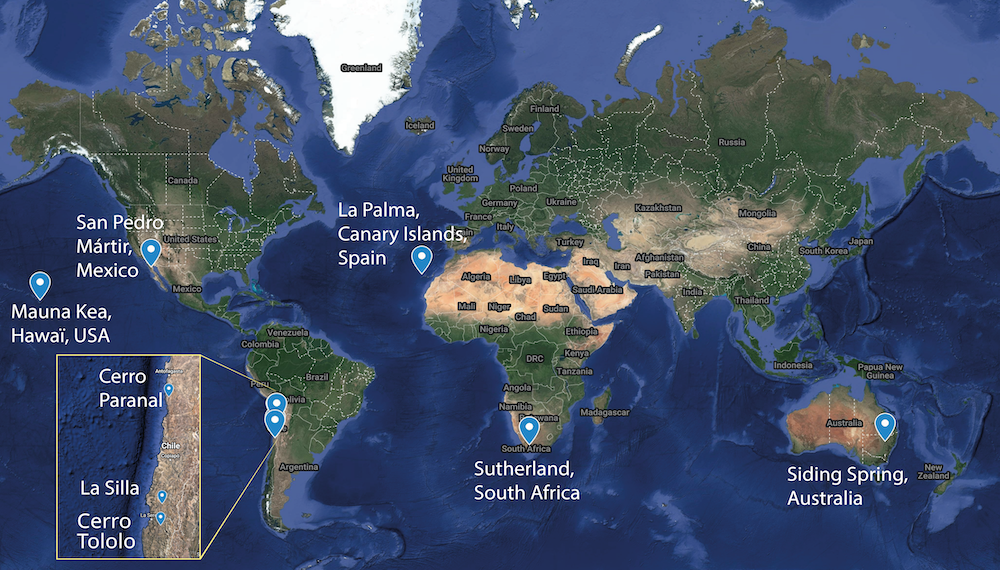The Effects of Climate Change on Astronomical Observing Facilities
Caroline Haslebacher (University of Bern/NCCR PlanetS) and her team look into how climate change will affect ground-based observations.
Read article in the fully formatted PDF of the Europlanet Magazine.
While climate change is nowadays an accepted reality, its impact on astronomical observations has been poorly studied due to a lack of suitable tools. Large ground-based observatories are high-cost projects so observing time lost due to unfavourable weather or climate conditions needs to be minimised, while the high quality of the acquired data must also be guaranteed. This means sites should be selected to have low cloud coverage, low humidity, low precipitable water vapour and good astronomical ‘seeing’ for observations in the visible and infrared.
Unfortunately, the local site conditions are not the only elements to be considered when selecting the site of new telescopes. Indeed, historical and political factors, such as pre-existing infrastructure or cultural environments, play an important role too. Moreover, the time-scale for site selection is usually too short to account for long-term changes in observing conditions, such as those arising from anthropogenic climate change, and the process is costly and thus limited in number and time.
As an example, the Thirty Meter Telescope (TMT) site selection started with a large set of candidates, out of which five were pre-selected to get a full climate study for up to five years. This is only a fraction of the lifespan of an observatory, and not enough to identify long-term trends due to climate change at a site. The timescale between the start of the selection process for the TMT and its estimated first-light spans three decades, to which its subsequent years in operation must be added, and famous observatories, such as La Silla in Chile or Teide in Tenerife, have been running for over fifty years, and keep receiving new instruments and telescopes.
Understanding the Past to Forecast the Future
Together with Prof Brice-Olivier Demory and an interdisciplinary team of astronomers and climate scientists, we initiated a project to study how various atmospheric conditions are expected to evolve due to climate change for eight major astronomical observing sites: Mauna Kea, Cerro Paranal, La Silla, Cerro Tololo, La Palma, Sutherland, Siding Spring and San Pedro Mártir. The code used to perform the study has been published as open-source in order to allow future studies of additional observing sites.

Such an extensive and detailed study on multiple observing sites has only been made possible by the advent of climate models with a high-enough resolution to investigate specific sites. The starting point for our team was to acquire as much in-situ weather data as possible for each observatory. The next step was to assess how well the climate models represent the current site conditions, as depicted by the in-situ data. First, we used a service called ERA5 from the European Centre for Medium-Range Weather Forecasts,1 which exploits physical models to reanalyse archived observational data and produce a homogeneous dataset. Second, we used global climate models (GCM) provided by PRIMAVERA,2 a project funded by the European Union (EU) Horizon 2020 programme, which simulate climate evolution from 1950 to 2050.3 PRIMAVERA provides six different GCMs, at the highest horizontal resolution (18-50 kilometres) available to date, which we averaged to produce one output. By comparing the PRIMAVERA results for the ‘historic’ period from 1950-2014 with the ERA5 reanalysis, our team could assess how well the PRIMAVERA, ERA5 and in-situ data agreed with each other. Once this was evaluated, we were able to project climate evolution for each observatory, assuming the worst-case scenario regarding greenhouse gas emissions.
A Mixed Picture
The projected impact of climate change on astronomical observations is not black and white. Results of the simulations suggest worsening observing conditions, although some aspects could potentially improve.
Out of several atmospheric parameters tracked and studied by the team, three display clear trends in their projected evolution. First, the total amount of water vapour in the air column above the observatory is likely to increase, resulting in a higher atmospheric absorption of light and a lower observation quality. Second, the temperatures are also likely to increase, which could impact the seeing, both in the atmosphere, due to higher temperature gradients, and within the dome. Third, although less certain, is a trend towards a slight decrease in relative humidity (the saturation of air with water vapour) at ground level. This may potentially reduce the number of dome closure events, which occur when there is a risk of water condensation forming on on critical telescope parts.
Of the eight facilities tested in the simulations, it seems that Mauna Kea in Hawaii will be the least impacted by climate change. However, it is also the site with the worst agreement with model data.
Of all the variables, cloud coverage and seeing evolution are currently poorly represented by the climate models, since the cloud processes are difficult to simulate and the vertical resolution in model outputs is insufficient to calculate the seeing. Nonetheless, improvements will soon be possible with NextGEMS, the next generation of GCMs, for which a 1-kilometre horizontal resolution is currently being calculated by supercomputers.
References
1. Hersbach et al. 2018a, DOI: doi.org/10.24381/cds.bd0915c6; Hersbach et al. 2018b, DOI: doi.org/10.24381/cds.adbb2d47
2. PRIMAVERA: www.primavera-h2020.eu
3. Haarsma et al. 2016, DOI : doi.org/10.5194/gmd-9-4185-2016


